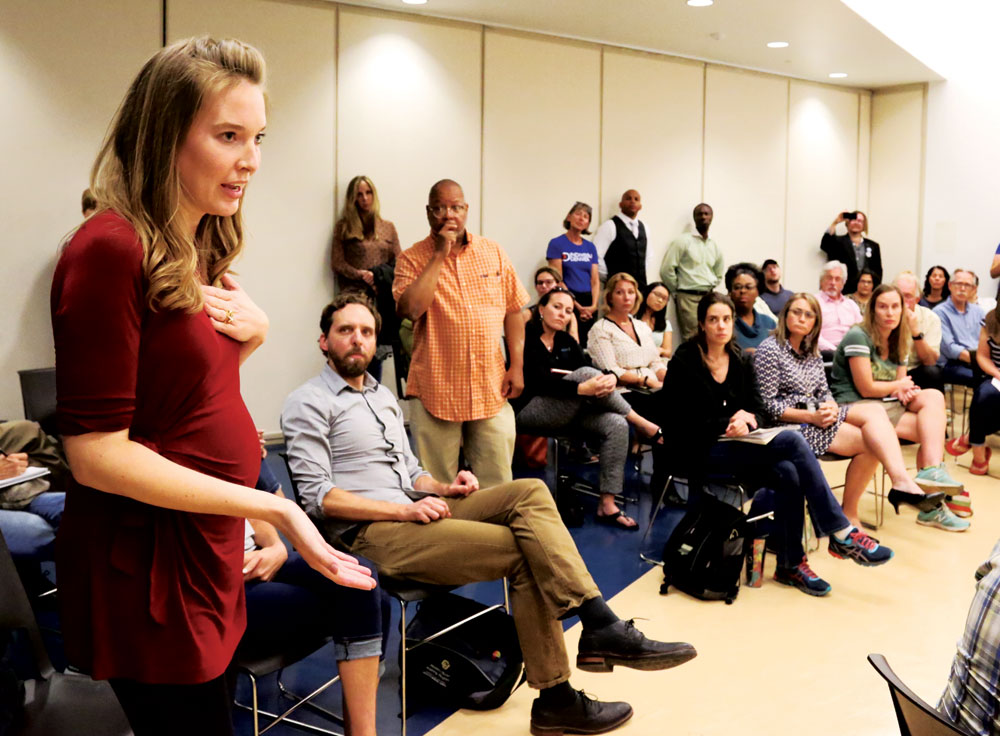
Jamie Hodgkins favors changing Stapleton’s name. She spoke at both the SUN meeting (above left) and at the CAB meeting . As an anthropologist, she says, “Symbols are incredibly important and they actually drive culture.”
A group of neighbors working on issues relating to racial and economic justice has identified #ChangeTheNameStapleton as the current focus of their efforts. The group brought their cause to the agenda at three citizens’ board and committee meetings in Stapleton during September. They feel passionately that because Mayor Benjamin Stapleton was in the KKK and put Klan members in positions of authority in Denver, he should not be honored by having a community named after him.
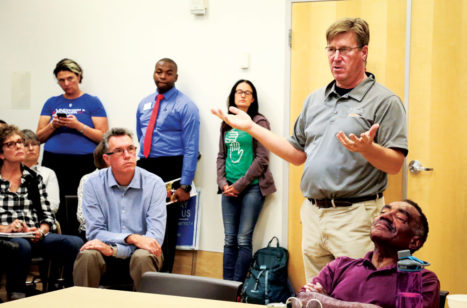
Keven Burnett, executive director of the Stapleton MCA, talks about the technicalities that would be involved to officially change the name. The name Stapleton is tied to all zoning documents with the city. And every property’s deeds, title documents and mortgage contains the word Stapleton in the property’s legal description.
At the Stapleton United Neighbors (SUN) meeting on September 17, attendees learned the magnitude of the task if the name were officially changed. Master Community Association (MCA) Director Keven Burnett told the group that any community can change its name with a vote of 67% of homeowners, but it is very difficult legally. From the first sale of land to Forest City, the property was legally named Stapleton. From that point on, the name Stapleton has been tied to all zoning documents with the city. All the deeds, title documents and mortgages contain the word Stapleton in the legal property descriptions.
In response to that information, a member of the audience spoke up. “We’re talking about the branding, the signage. The name of our neighborhood association.”
Bryan Penny, one of the founders of the neighborhood association acknowledged, “I think the name of our neighborhood association could send a signal to these other things…but give us the time so we can make…the best decision for the community.” Not, he said, a rash decision that could come back to haunt them.
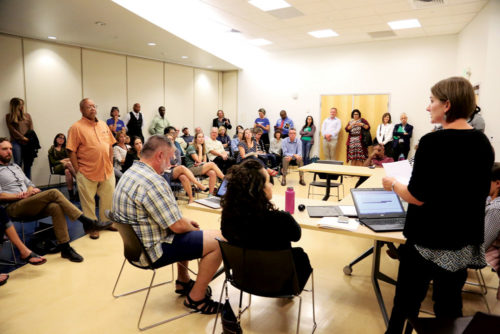
Amanda Allshouse (above right), president of Stapleton United Neighbors (SUN), informed the group of SUN’s Inclusivity Action Plan and reads its eight points.
SUN Board President Amanda Allshouse read an Inclusivity Action Plan—actions the organization will take to promote the goals of inclusivity and diversity (listed on page 40). But with ten minutes allocated for comments, the #ChangeTheNameStapleton attendees were more focused on presenting their demand that SUN remove Stapleton from its name than on hearing the legalities or SUN’s action plan.
The first speaker, Gregory Diggs, pointed out that the community responded quickly when swastikas were painted on a local school. And it responded quickly to condemn Charlottesville in a public letter. “We didn’t have to wait for consensus or a vote. At a time the country is dismantling its monuments to white supremacy, it is time for us to dismantle ours.”
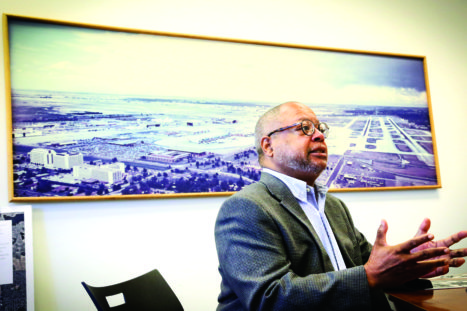
Gregory Diggs (right) says whereas the rest of the #ChangeThe NameStapleton group will use Martin Luther King-style methods to peacefully but insistently push their cause, he will be an agitator. “When we have peaceful conversations, there’s no urgency.”
Far right: Justin Ross (left) and Tom Gleason (right) listen to Jamie Hodgkins talk about the cultural importance of symbols.
Caley Orr offered empathy to those who are on the fence about changing the name. “I was initially on the fence. I thought, “What does it matter? There are bigger fish to fry. But we are the privileged people, surrounded on all sides by areas that have much different demographics than we do. We have to find a way to make this change. We can come up with another way to brand and name the place we live, whether it’s legally or not.”
As the meeting ended, a voice in the room called out, “If I had to wait for community consensus, I would still be a slave.” Another voice added, “No change ever came from consensus, ever.”
At another meeting, a sub-committee of Stapleton’s Citizens Advisory Board (CAB), a group has gathered monthly for many years to talk about ways to promote more affordable housing and diversity in Stapleton. #ChangeTheNameStapleton brought their cause to be discussed at that group’s September meeting—and following that meeting, the issue was placed on CAB’s September agenda for discussion by the larger group.
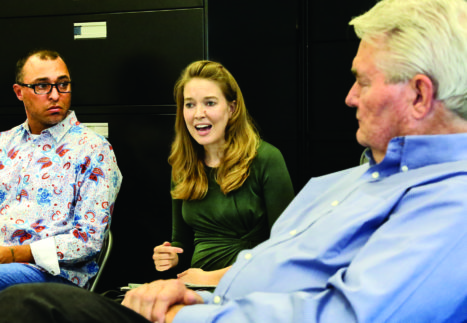
Jamie Hodgkins speaks at the Citizen’s Advisory Board (CAB) meeting
CAB chair Jim Wagenlander said CAB has “consistently and continuously pushed for more diversity at Stapleton.” He added that changing the name “for some is a tactic to increase diversity and for others it’s a way to attack racism and bigotry.” He saw the discussion as an opportunity to explore the best and most effective means to increase diversity in the community.
Justin Ross, one of the earliest Stapleton residents said, “I think symbolically it’s an easy thing. I don’t think the long line of people prepared to buy homes in Stapleton would stop buying homes if Stapleton is dropped from FC advertising.” But as the owner of a business with Stapleton in its name and with many years spent establishing the reputation and identity of his business, Ross said he would be concerned about reestablishing it with a different name.
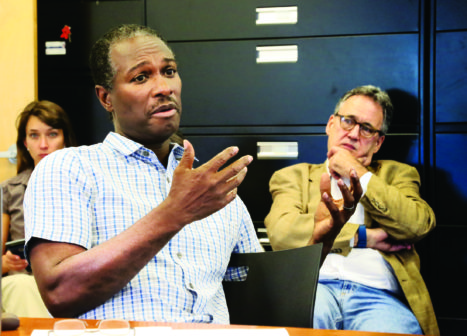 The difficulty of getting people to adjust to a new name was raised—people will just keep using the old name. The example of Fitzsimons/Anschutz was cited. Oldtimers may call it Fitzsimons, but Caley Orr, who works there, said the younger generation, at least, calls it Anschutz. “In a generation,” he says, “it will change.”
The difficulty of getting people to adjust to a new name was raised—people will just keep using the old name. The example of Fitzsimons/Anschutz was cited. Oldtimers may call it Fitzsimons, but Caley Orr, who works there, said the younger generation, at least, calls it Anschutz. “In a generation,” he says, “it will change.”
Tom Gleason pointed out that Forest City has named all the neighborhoods, streets and parks and not one has Stapleton in the name—and added that the vision was that individual neighborhoods, like Eastbridge or Conservatory Green would develop their own neighborhood identities.
Diane Deeter of the Stapleton MCA followed Gleason’s statement by telling the group that Forest City recently hosted a new homes event, and the marketing material did not have the Stapleton logo on it, “the first time that’s happened,” she said.
Landri Taylor, Stapleton Foundation president, reminded the group that the founding fathers were white supremacists who owned slaves, “But we’re not renaming the Constitution.” And he pointed to all the work that’s been done to create a community with businesses that provide employment where none existed before.
Wagenlander, the CAB chair encouraged everyone to continue to have civil discussions, adding, “Inflaming this issue will turn off people we need to convince to do this [create more diversity]. CAB will address this and the greater issue strategically and tactfully and work with people of all opinions as long as they are interested in making Stapleton more diverse and have more affordable housing.”



Great to see this conversation. Kuddos to the neighborhood for taking this on!